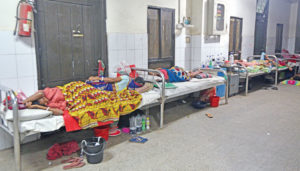Collapse of hygiene management in hospitals in Bangladesh
March 20, 2020
By: Rashad Ahamad
This article was originally posted by New Age Bangladesh.
Cleanliness, poor quality supply water, sanitation and hygiene as well as unsafe management of medical wastes in hospitals in Dhaka and elsewhere in Bangladesh together paint a dismal picture of hygiene practice in Bangladesh.
Appallingly ignored and neglected, hygiene management in health care facilities are potentially dangerous factors for spreading infectious diseases, said experts.
Even during the COVID-19 pandemic that has already killed more than nine thousand people across the world and infected many more in at least 170 countries, the hospitals seem reluctant about making any improvement in their hygiene and cleanliness practices.
Considering the practices and practical situation of the hospitals, experts said that people were in high danger of nosocomial infection.
New Age reporter visited at least four hospitals in the capital from March 15-19 and observed that hospital staffers, infrastructures, patients and their relatives all were very reluctant about maintaining hygiene.
None of the Dhaka Medical Collage Hospital, Dhaka Shishu Hospital, Shaheed Suhrawardy Medical College and Hospital and National Institute of Traumatology and Orthopaedic Rehabilitation was found clean. In terms of maintaining hygiene, they all fall far short. Especially when one is using their toilets, the realisation dawns that even in hospitals cleanliness is not a priority.
The appalling state of the toilets could hardly described. Bad smell filled the air in the dark, damp, filthy toilet in which garbage is scattered on the floor. The experience is gut wrenching as toilets are seen flooded with faeces.
There was no sign of soaps and tissue papers though those are things necessary in toilets that are used by patients, their relatives and junior staffers of hospitals.
Toilets in the public hospitals are all squat toilets and no modern flushing system is there.
The above descriptions apply only to the toilets used by the public while the toilets for doctors and senior official are off limit to the public.
DMCH director Brigadier General AKM Nasir Uddin admitted that the allegations against the hospital are true and said that the hospital authority tried time and again to provide hand washing soaps but failed.
He said that every time we provides the soap, it would soon get stolen by as unidentified people.
He said that hygiene in hospitals was very much important than any other places and urged the patients to maintain their hygiene of own accord.
He said that the hospital management put up a number of posters and festoons for creating awareness about hygiene among the patients and visitors.
‘We urge visitors not to come to the hospital if they did not have any emergency. Visitors are the main challenge for hygiene in hospital,’ he said.
During multiple visits to Shaheed Suhrawardy Medical College and Hospital at Sher-e-Bangla Nagar in the capital the toilet floor of male medicine ward was found under water.
Four waste bins were kept there at a corner where different types of disease-carrying vectors were thriving.
Patients and their relatives were collecting water and washing their dishes there while bathroom water regularly kept a portion of the ward under water.
A number of patients admitted to the hospital amid acute seat crisis, also took shelter on floor mats.
Rafiquel Islam, a relative of a patient said that he was staying with his father since March 2 but did not find any soap for a single day in any of the bathrooms.
Rafiquel is from Brahmanbaria and hge was admitted to the hospital as his father’s leg had to be amputated after an infection.
SSMCH director Uttam Kumar Barua’s mobile phone was found switched off after repeated attempts at contacting him. Following two subsequent visits at his office on Wednesday and Thursday, he was found absent.
New Age contacted the other officials but they declined to comment on the issue.
The scenario at Dhaka Shishu Hospital was not much different. There is no hand washing facilities with soap even after defecation.
Abdul Hakim, public relation officer, and also spokesperson of the hospital, said that they could not provide soaps as soaps get stolen within hours after they are supplied.
About cleanliness, he said that the hospital had no sufficient cleaners of its own so they leased out the work to Nepcons Cleaning Service, a private company.
Nepcons cleaning in-charge Ajay Kumar Nipu said that the hospital provide them with Tk 4.9 lakh each month for cleaning purpose under an agreement signed three years ago.
‘It is very insufficient to ensure high-quality cleanliness but regular cleaning is monitored done,’ he said.
He added that buying equipment and providing salary of 150 cleaners was very challenging within the budget.
It was not only that the inside of the hospital building looked dirty and unhygienic, but also the entire premises was dirty.
Aynal Hossain, father of a patient at the specialised hospital for children made a complaint that mosquito menace was acute at the hospital even when the city people were living in acute fear of dengue.
Mohammad Abdul High, admitted to Dhaka Medical College Hospital for lever infection, said that the hospital was very dirty and hygiene was hardly maintained.
He said that all visitors, doctors and staff members enter the wards without any protection.
Public health expert and country director of WaterAid Bangladesh Khairul Islam said that hygiene situation could be improved manifold if hospital authorities developed a pragmatic management system.
Bangabandhu Sheikh Mujib Medical University public health and informatics department associate professor Romen Raihan said that there was no alternative to controlling visitors in hospitals to check hygiene.
He also emphasised that trained sweepers should be employed and proper management of medical waste should be maintained.
He urged the hospital authority to follow guidelines and safe management of hospital linen.
Experts said that management of health-care waste was an integrated part of hospital hygiene and infectious disease control. The waste should be considered a reservoir of pathogenic microorganism, which can cause contamination and infection.
If hospital hygiene is not maintained properly, these microorganisms can be transmitted by direct contact through air and a variety of vectors, putting the health of hospital personnel and patients at risk.
Dirty toilets and murky hand-washing basins, which are hardly functional, are not only restricting peoples’ access but also affecting their hygiene practices at hospitals.
Furthermore, the overall environmental safety of a public hospital is compromised due to the lack of the collection, segregation and safe disposal of hospital waste.
Various studies revealed that proper WASH provision and practices could reduce disease transmission.
Globally, hospitals maintain special hygiene compared to residences or offices because people with diseases are admitted there.
As part of hygiene maintenance, they put emphasis on cleaning, sterilization, disinfestations and hand washing, doctors said.
Cleaning is one of the basic measures for the maintenance of hygiene and particularly important in the hospital environment. The principal aim of cleaning is to remove visible dirt. It is essentially a mechanical process. Soaps and detergents act as solubility promoting agents. The efficacy of the cleaning process depends completely on mechanical action as cleaning will remove 90 per cent of the microorganisms.
Sterilisation is another process which can be achieved both physical and chemical means. Physical method based on heat includes autoclaving, dry thermal or wet thermal sterilisation. Chemical mean gas sterilisation with ethylene oxide or other gases are also effective.
There is no ideal disinfectant and the best method should be chosen according to the situation.
More than 90 per cent of the transient microorganisms can be removed through hand washing with adequate safe water and soap.
Experts said that Bangladesh lack all measures of hygiene in most of the hospitals as its staffs were not trained.
Although waste management is the key responsibility of the City Corporation but none of the city corporations in Bangladesh have the capacity to treat medical waste.
Medical waste frequently found dotting open spaces including drainage and wetland.
The essential requirements like safe drinking water, water for hand washing, basic sanitation facilities, safe health-care waste management facilities, clean floors and fittings and hygiene messages need to be provided to the staff, patients and attendants for maintaining clean and healthy environment in the hospital.
The World Health Organisation guideline ‘Essential Environmental Health Standards in Health Care’ and government’s ‘Medical Waste Management Rules-2008’ remained on paper in case of hospitals in Bangladesh.
World Health Organisation referred to a study that showed that patients infected with diseases accounted for 50 per cent of in-patient and 33 per cent of out-patient consultations adding an extra burden to hospital services that were often already overstretched.
Providing access to sufficient quantities of safe water, adequate and sound sanitation facilities, proper health-care waste management systems and introducing sound hygiene behaviour communication systems could reduce the amount of disease transmission, the study said.
Icddr,b reported that nosocomial infection can cause severe pneumonia and infections of the urinary tract, blood stream and other parts of the body and often are difficult to manage by antibiotics which in turn can increase the emergence of resistant strains of antibiotics.
These kinds of infections were commonly spread when hospital officials became complacent and did not maintain correct hygiene practice on a regular basis like maintaining sanitation protocol regarding uniforms, equipment sterilisation, washing, and other preventative measures.
From April 2007 to March 2008, Icddr,b conducted a low-cost surveillance in three hospitals to identify the onset of new respiratory symptoms in patients hospitalised for more than 72 hours and in health care workers in medicine and paediatric wards.
During 46,273 patient-days of observation, 136 episodes of hospital-acquired respiratory diseases were recorded, representing 1.7 per cent of all patient hospital admissions.
The ward with higher bed occupancy rates poses an increased risk to patients.
Twenty five per cent of hospital-acquired respiratory disease occurred in patients hospitalised for cardiovascular disease, stroke, and myocardial infarction which is concerning, because acute respiratory illness in this group, particularly influenza, is associated with increased risk of complications and poor health outcomes and patients leaving with respiratory infections pose a health risk to others in the communities.
Of the 226 heath care workers who worked on the surveillance wards, 27 per cent experienced a respiratory illness during the study period. Thirty of the 40 health care workers on the adult medicine ward experienced respiratory illness compared with 6-24 per cent of staff members on other wards.

